Structure of chloroplasts - Study guides, Class notes & Summaries
Looking for the best study guides, study notes and summaries about Structure of chloroplasts? On this page you'll find 1509 study documents about Structure of chloroplasts.
Page 4 out of 1.509 results
Sort by
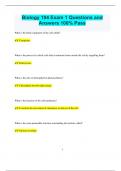
-
Biology 104 Exam 1 Questions and Answers 100%
- Exam (elaborations) • 21 pages • 2024
-
- $9.99
- + learn more
Biology 104 Exam 1 Questions and Answers 100% Pass What is the fluid component of the cell called? Cytoplasm. What is the process by which cells take in nutrients from outside the cell by engulfing them? Endocytosis. What is the role of chlorophyll in photosynthesis? Chlorophyll absorbs light energy. What is the function of the cell membrane? It controls the movement of substances in and out of the cell. What is the semi-permeable structure surrounding the nucleus cal...
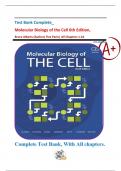

-
Test Bank Complete_ Molecular Biology of the Cell 6th Edition, Bruce Alberts (Author) Five Parts| All Chapters 1-24
- Exam (elaborations) • 427 pages • 2024
-
- $17.00
- + learn more
Test Bank Complete_ Molecular Biology of the Cell 6th Edition, Bruce Alberts (Author) Five Parts| All Chapters 1-24 Part I Introduction to the Cell……………………………………….……………3 Chapter 1: Cells and Genomes……………………………………………………………………………….….…………………...3 Chapter 2: Cell Chemistry and Bioenergetics………………………………………………………..………………….…….1...
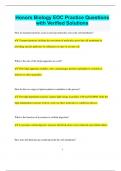
-
Honors Biology EOC Practice Questions with Verified Solutions
- Exam (elaborations) • 23 pages • 2024
- Available in package deal
-
- $9.99
- + learn more
Honors Biology EOC Practice Questions with Verified Solutions How do transport proteins assist in moving molecules across the cell membrane? Transport proteins facilitate the movement of molecules across the cell membrane by providing specific pathways for substances to enter or exit the cell. What is the role of the Golgi apparatus in a cell? The Golgi apparatus modifies, sorts, and packages proteins and lipids for secretion or delivery to other organelles. How do the two stag...
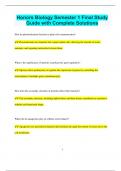
-
Honors Biology Semester 1 Final Study Guide with Complete Solutions
- Exam (elaborations) • 15 pages • 2024
- Available in package deal
-
- $9.99
- + learn more
Honors Biology Semester 1 Final Study Guide with Complete Solutions How do plasmodesmata function in plant cell communication? Plasmodesmata are channels that connect plant cells, allowing the transfer of water, nutrients, and signaling molecules between them. What is the significance of operons in prokaryotic gene regulation? Operons allow prokaryotes to regulate the expression of genes by controlling the transcription of multiple genes simultaneously. How does the secondary str...
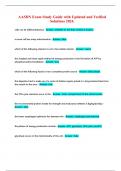
-
AASDN Exam Study Guide with Updated and Verified Solutions 2024.
- Exam (elaborations) • 25 pages • 2024
-
- $15.99
- + learn more
the lower esophageal sphincter lies between the - Answer- esophagus and stomach the phases of energy production include - Answer- ATP, glycolysis, TCA cycle, and ETC glycolysis occurs in the mitochondria of the cell - Answer- false A molecule with a structure composed primarily of amino acids would be classified in which of the following groups? - Answer- Proteins The product made by chloroplasts
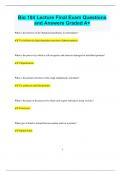
-
Bio 104 Lecture Final Exam Questions and Answers Graded A+
- Exam (elaborations) • 28 pages • 2024
-
- $9.99
- + learn more
Bio 104 Lecture Final Exam Questions and Answers Graded A+ What is the function of the thylakoid membranes in chloroplasts? To facilitate the light-dependent reactions of photosynthesis. What is the process by which a cell recognizes and removes damaged or misfolded proteins? Ubiquitination. What is the primary function of the rough endoplasmic reticulum? To synthesize and fold proteins. What is the name of the process by which cells export substances using vesicles? Exocy...
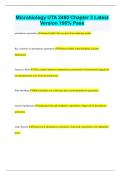
-
Microbiology UTA 2460 Chapter 3 Latest Version 100% Pass
- Exam (elaborations) • 17 pages • 2024
- Available in package deal
-
- $9.99
- + learn more
Microbiology UTA 2460 Chapter 3 Latest Version 100% Pass spontaneous generation ancient belief: life can arise from nonliving matter Key scientists of spontaneous generation Francesco Redi, John Needham, Lazzaro Spallanzani Francesco Redi This scientist disproved spontaneous generation by showing that maggots do not spontaneously arise from decaying meat. John Needham Believed there was a life force that caused spontaneous generation Lazzaro Spallanzani replicated redi and ne...
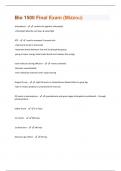
-
Bio 1500 Final Exam (Questions & Answers) Rated 100%
- Exam (elaborations) • 16 pages • 2024
-
- $7.99
- + learn more
chloroplasts - -contain the pigment chlorophyll -chlorophyll absorbs red, blue, & violet light ATP - -used to transport E around cells -chemical E stored in the bonds -important bonds between 2nd and 3rd phosphate group -going to lower energy state breaks bonds and releases the energy each molecule during diffusion - -moves randomly -behavior unpredictable -each individual molecule never stops moving dragon fly size - -high O2 levels in carboniferous allowed them to grow big -later in ...
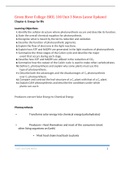
-
Green River College: BIOL 100 Unit 3 Notes Latest Updated,100% CORRECT
- Class notes • 116 pages • 2023
-
- $16.99
- 1x sold
- + learn more
Green River College: BIOL 100 Unit 3 Notes Latest Updated Chapter 6: Energy for life Learning Objectives: 1. Identify the cellular structure where photosynthesis occurs and describe its function. 2. State the overall chemical equation for photosynthesis. 3. Recognize what is meant by the terms reduction and oxidation. 4. Describe the function of photosynthetic pigments. 5. Explain the flow of electrons in the light reactions. 6. Explain how ATP and NADPH are generated in the light reac...
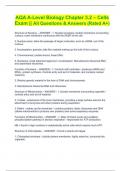
-
AQA A-Level Biology Chapter 3.2 – Cells Exam || All Questions & Answers (Rated A+)
- Exam (elaborations) • 24 pages • 2024
- Available in package deal
-
- $12.50
- + learn more
AQA A-Level Biology Chapter 3.2 – Cells Exam || All Questions & Answers (Rated A+) AQA A-Level Biology Chapter 3.2 – Cells Exam || All Questions & Answers (Rated A+) Structure of Nucleus. - ANSWER - 1. Nuclear envelope: double membrane surrounding nucleus, outer membrane continuous with the (R)ER of the cell. 2. Nuclear pores: allow the passage of larger molecules, such as mRNA, out of the nucleus. 3. Nucleoplasm: granular, jelly-like material making up the bulk of the nucleus. ...

That summary you just bought made someone very happy. Also get paid weekly? Sell your study resources on Stuvia! Discover all about earning on Stuvia


